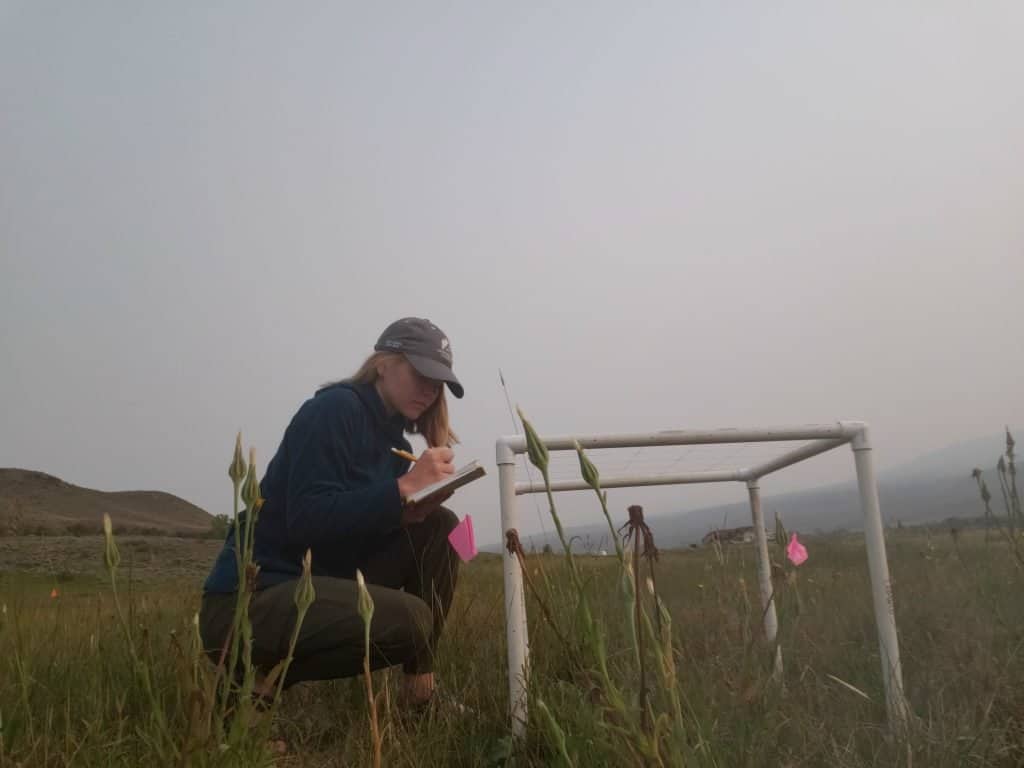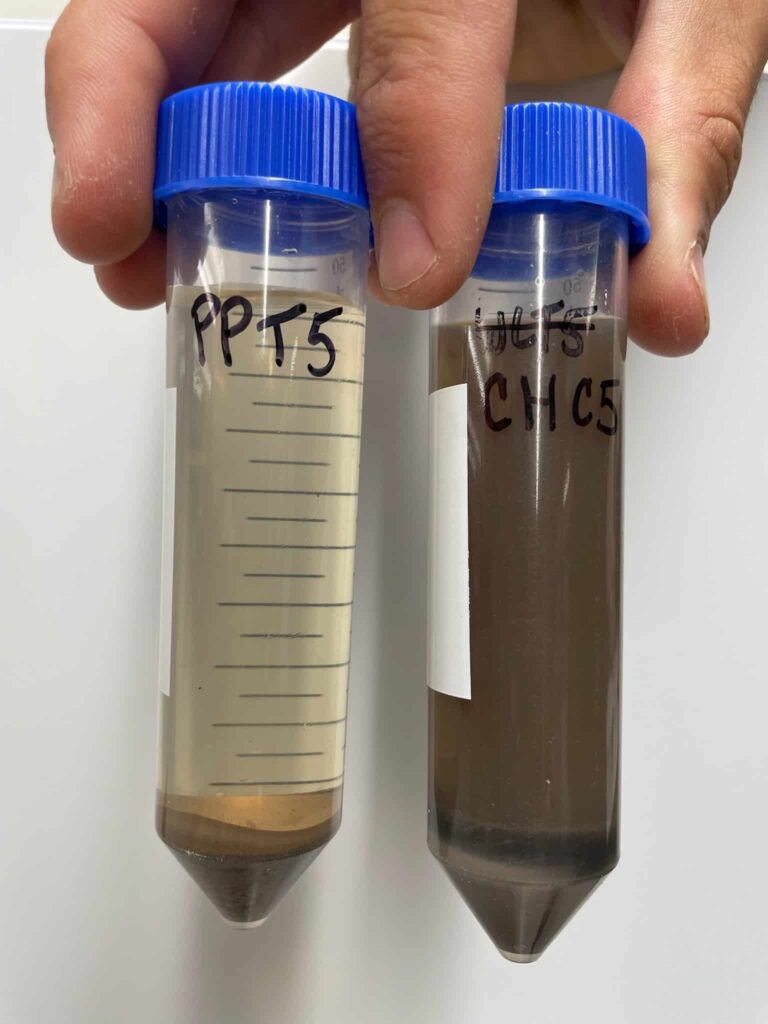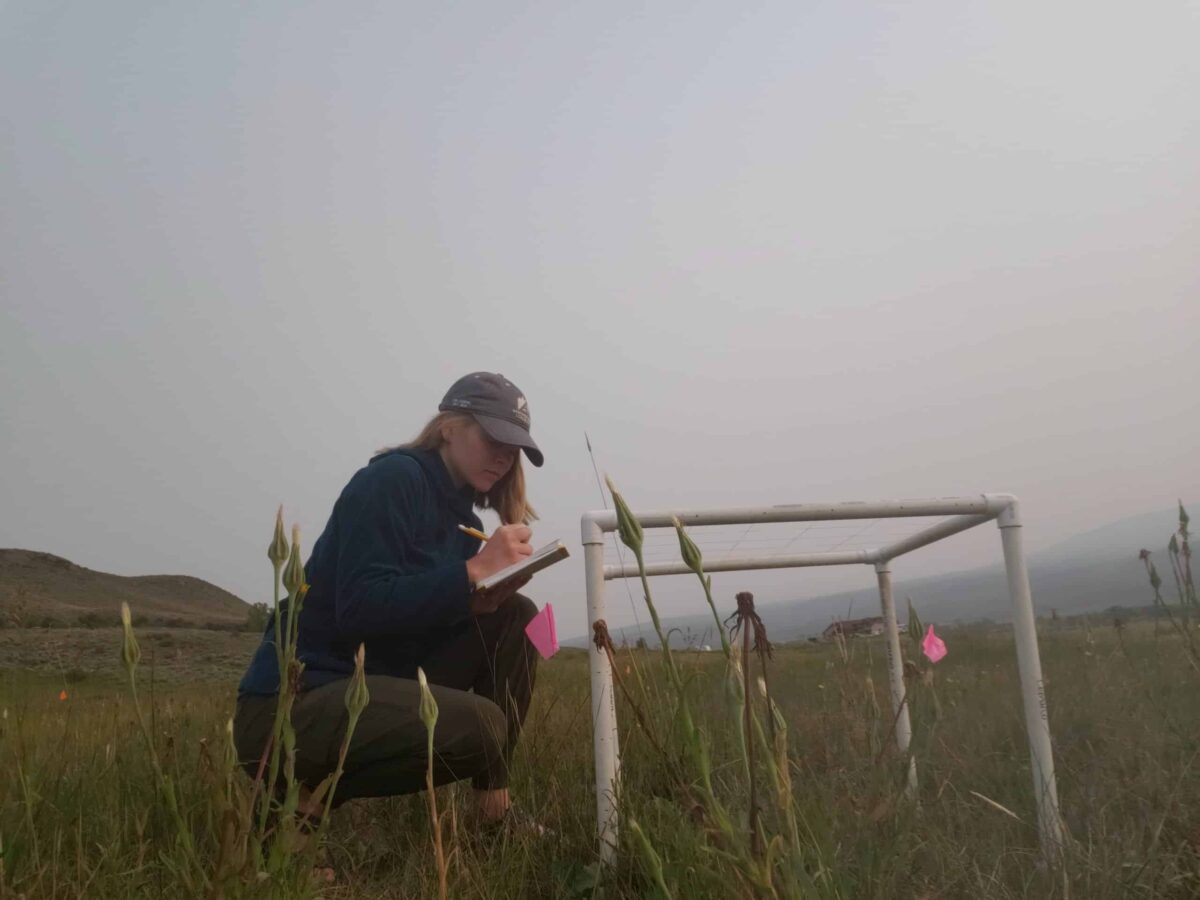
Compost is many things—a nutritious boost for vegetative life, an example of circular economy principles in which our collective waste is not landfilled (where it can generate greenhouse gas as it decomposes), but instead remade into a usable product, and perhaps—a key ingredient to solving our climate crisis in the form of storing carbon in soils.
Shaun McGrath is a graduate student finishing out her Master’s in Environmental Management (MEM) degree with a keen interest in compost, soils, and climate change. McGrath came to Western as a transfer student, quickly deciding to pursue the university’s 3+2 degree option, which grants a Bachelor’s and Master’s degree in the span of five years.
To gain entrance to the accelerated program, McGrath needed relevant internship experience, and began working under the tutelage of Alexia Cooper, an MEM student who graduated back in 2020 and jump-started a multi-year compost and soil research project by obtaining funding from the Sustainable Agriculture Research and Education grant program (SARE).
Cooper’s study included an initial compost application, a 2-inch surface layer of Gunni Gold (a biosolid compost from the local wastewater treatment plant) to three different rangeland plots near Gunnison.
McGrath notes that during that initial research year, Cooper’s efforts paid off—she observed significant increases in plant biomass (the total weight of living things) and soil moisture four months after treating her research plots with compost.
But at the end of the first study year McGrath was left with a big question: How long would that initial compost treatment continue to produce results? That internship inspired McGrath, who had a budding interest in soils, to pursue a similar research track for her own upcoming graduate project, with an eye towards the long-term climate impacts of compost application on rangelands.
The next year, while McGrath prepared to launch her study, Master’s of Science in Ecology (MSE) student Alex VanTill took over the plots, conducting research into the impacts of compost on microorganisms.
VanTill’s research examined how microorganism activity could impact carbon storage in soil. McGrath says that her predecessor’s research tested the hypothesis that the microorganisms might release all the carbon quickly, which would be a poor sign for compost’s ability to serve as a climate mitigation tool, which requires storing carbon in the soil for the long haul. Ultimately, VanTill’s research suggested that the initial application of compost made under Cooper does in fact help retain carbon in soils.
Now it was her turn, and so McGrath, under the mentorship of Dr. Jennie Demarco—a professor and ecologist who recently departed Western for an assistant professorship at Southwestern University, and who had previously mentored both Cooper and VanTill—assumed control over the ongoing study.
McGrath wanted to know whether the compost treatment’s benefits would continue three years into the project: “What is the climate mitigation potential of compost amendments on range lands? Are we seeing an increase of carbon stocks in the soil?”
To get at that fundamental question, her study examined where in the soil profile carbon is stored. To do this, she used a method known as density fractionation, which separates soil by its size and density (siltier clay is on the denser end, and darker, more organic and “fluffier” soil is on the lighter side).
These different fractions have different carbon storage times—the lighter fraction is stored for short periods, and the heavier fraction for longer ones—ideal for the purpose of climate mitigation.

To accomplish that separation, McGrath had to rinse and process each of the study’s 30 soil samples, which became 60 sub-samples after the fractionation process. Having begun her field work in June, she pulled the soil samples in September, and quickly turned her attention to the time-intensive laboratory analysis, venturing to Texas for a 10-day stint to work at Professor Demarco’s Southwestern University lab, sleeping on the floor as she worked through the samples.
Unfortunately, McGrath ran into some research delays during the painstaking process, and departed with about half the samples finished and the intention to return for a short stint in January.
Back in Gunnison, Covid erupted after the Holidays, and McGrath was unable to return to Texas. Instead, she gave the go-ahead to the undergraduate students at Southwestern University to finish processing the samples.
That density fractionation process, now complete, separated the light soil fraction, newly-added carbon in the form of organic matter that is highly accessible to the microorganisms (and thus is released into the atmosphere quickly), and the heavy fraction, chemically-bound and inaccessible to the microorganisms.
“Carbon, if it’s in the heavy fraction, can be there for thousands of years,” McGrath notes. “The light fraction, that carbon will [only] be there for three to five years.”
When the samples did come back, her results pointed to some remnant benefits of the compost application, specifically in sites which had lower amounts of organic matter to start with.
Now, having walked at graduation, McGrath is awaiting final analysis on the specifics of where the increased carbon stocks come from—the light or the heavy fraction of the soil—from the laboratory at Colorado State University, which has an elemental analyzer to examine the soil.

“If we see an increase [in carbon stocks] there will be an increase in the [soil’s] light fraction, [because carbon] can’t go straight to the heavy fraction, just based on how the carbon cycle [works],” says McGrath, who adds that the added compost may in fact be helping store compost in the heavier soil, which would be great news for the climate.
Parsing out whether the carbon has made it into the heavier soil three years after the initial compost application is the fundamental question McGrath, and much of the soil science community, would love to answer.
“It is just not sustainable to expect ranchers to reapply [compost] every single year,” says McGrath, who notes that several of the initial benefits of compost application, like soil biomass and moisture, have worn off over time. As with many research projects, McGrath’s research, building off of Cooper’s and VanTill’s projects, invites many more questions.
“What if we added more compost—still one time—but more of it: would that change the effects? Or what if we did less of it but every year?” asks McGrath.
Or perhaps compost could be combined with biochar (think compost plus charcoal), an increasingly hot topic of study in the last few years, and one that rising second year MEM student Matthew Eshed is looking to study at Coldharbour Institute as part of his graduate project.
Contemplating her final analysis, McGrath is also wrestling with environmental factors that likely complicated her research. “There’s also a chance that our compost got swept up because they flood irrigate our pastures—so was the compost even still there?” she asks.
The nature of the three study sites—all distinct in nature—also could have influenced the results. The first research plots are at Coldharbour Institute, a nonprofit education and environmental research center situated roughly 7 miles east of Gunnison, and closely affiliated with Western.
“That one’s interesting. It’s the least diverse in terms of the plants, so it’s really easy to monitor there. But it’s really high in organic matter and really healthy because it was left fallow for over 20 years and just recently reopened to cattle grazing,” she notes.
“Even then, it’s very infrequent grazing, so that site already has a lot of organic matter, which is why I think we’re seeing less significant results there…it didn’t necessarily need more organic matter.”
The second site is Parker Pastures, a ranchland property sandwiched between Highway 135 and the Gunnison River on the northwest end of town. McGrath notes that the land, leased from the Bureau of Land Management (BLM), has been holistically managed for more than 10 years with consistent, but rotational, cattle grazing.

“They also have a super healthy site with abundant hay because they don’t let their cattle graze in one spot for too long. In the peak growing season they move their cattle every 12 hours,” she notes.
Finally, there is Wiley Lane, the only site which has been hayed historically. “I think that contributes to the lower amount of organic matter, and to the abundance of plants that we see there,” says McGrath.
The research site itself is no longer hayed, but the surrounding land still is. Cattle grazing on the property is also more recent than the other two sites, but with fewer head of cattle. Another key factor to examine is the land’s significant slope, which contributes to the significant draining of soil.
“If any of the sites lost their compost, it would be Wiley Lane [just] because of the incline,” relays McGrath, which could explain why no difference was observed in the moisture content between the control and treatment plots there.
McGrath says that the different land histories and management practices can make for a difficult interpretation for her study, but opens up a broader discussion and analysis about land and soil health, and how various management techniques can influence natural processes and interact with the treatment compost differently.

McGrath’s research appears to indicate that the benefits of applying compost to sites with high existing organic content is minimal, but that semi-frequent applications to sites with lower organic content could produce significant benefits for the land.
McGrath notes that another confounding factor is that the compost could not be tilled into the soil at the three study sites because they are all active range lands, which may have contributed to high levels of runoff in the study’s early stages.
Now, at the end of her graduate journey, McGrath is wrestling with the “insignificance” of her data, a common theme among graduate students and academic researchers. Statistical significance—data that strongly suggests a specific, quantitatively-backed conclusion—is often an unspoken requirement for publication in scientific journals.
Journals have an incentive to only publish the most exciting and novel findings. Achieving publication boosts a researcher’s career and their funding prospects, and often encourages similar, related research efforts.
Having insignificant data, on the other hand, often leads to research going unpublished, and, as McGrath points out, can hinder science in that others may set off down similar research pathways without access to the findings garnered by so-called “insignificant” findings.
The fear of returning insignificant data at the end of lengthy, often expensive research has also led some researchers to manipulate their data, offering dishonest, skewed results. This can lead to problems with replication, a key aspect of science, when further research cannot mimic the previous, fudged results.
McGrath recalls a conversation she had with Dr. Garrett Smith, an Environment and Sustainability (ENVS) Lecturer at Western, who argued that “insignificant” findings should be published in a theoretical “Journal of Insignificance” for the benefit of future researchers. “[That research] still is important, I just think we don’t value it enough yet,” says McGrath.
Should McGrath’s research on biosolid application on semi-arid range lands fail to be published, she worries others will pursue very similar research conditions and produce insignificant, unpublishable data, thus perpetuating a cycle of research which could have been carefully directed at other, more productive efforts, squandering precious resources in the pursuit of climate action and improved land health.
Despite these concerns,McGrath points to other research being done in the field of range lands and soil health which could be applied to the Gunnison region in the future, including a California study which examined soil biomass right before and after grazing events.
“You could see that there was significantly more biomass [in the California study’s plots] before they grazed it, but afterwards there was just about the same, and it’s because the cattle actually prefer the forage that is compost-treated, because it’s higher quality,” says McGrath.
She notes that selective cattle grazing could have evened out her own biomass data, a theory backed up by anecdotal observations from the Parkers. “I think so much more research can go into those research plots—doctoral level research,” concludes McGrath, who raises the intriguing prospect of enacting policies to pay farmers to store carbon in the soil.
For now, McGrath is leaving the world of academia behind as she ties up her final analysis, and has accepted a job that began May 12 as a Geochemistry Lab Analyst for ACZ Laboratories in Steamboat Springs, an environmental testing laboratory that performs a variety of testing services for mining companies, industry clients, and government entities.

